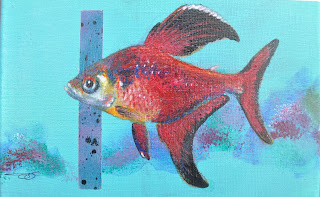The fossil quarry Miste (Winterswijk, The Netherlands) is well known for its fish otoliths. A single otolith, previously determined as †Prolebias weileri Von Salis 1967 by Schwarzhans (2010) is now assigned to the fossil genus †Paralebias.
 (Photo:) I am keeping the one and only small [very small!] piece of evidence proving the cyprinodont family Pantanodontidae once lived in The Netherlands, in my hand! The type specimen (the tiny, yellowish spot of hardly 1 mm in the center of the container) is kept at Naturalis Biodiversity center. (Leiden, The Netherlands).
(Photo:) I am keeping the one and only small [very small!] piece of evidence proving the cyprinodont family Pantanodontidae once lived in The Netherlands, in my hand! The type specimen (the tiny, yellowish spot of hardly 1 mm in the center of the container) is kept at Naturalis Biodiversity center. (Leiden, The Netherlands).†Paralebias sp. Miste is the most northern cyprinodont (fossil ánd extant) found in Europe thusfar. Its closest relatives are found 700 km south of Miste in the Mainz basin (Germany). The quarry is of Miocene age (estimated 15-10 Ma); as such this species is the youngest fossil species of †Paralebias.
Together with Jean Huber I have finished a comprehensive review on Pantanodontidae. Besides the fossil genus: †Paralebias Gaudant 2013 and Pantanodon Myers 1955 (until recently the only extant genus in this family) we described two new extant genera and five new species. We suspect the diversity in extant species in this family, only found in East Africa and of which some are considered extinct, to be even greater.
All of the known fossil species are found in Europe; a new study will show the diversity in this genus certainly is greater than presently understood.
More details in my blog "For real" (and the references below).
More details in my blog "For real" (and the references below).
The map above shows the distribution and (estimated) age of all presently valid species. Artist impressions ©Eduard Meinema.
References:
Meinema, Eduard & Jean H. Huber (2023): Review of Pantanodontidae (Cyprinodontiformes) and its fossil and extant genera Pantanodon Myers, 1955 and †Paralebias Gaudant, 2013 with descriptions of two new recent genera and five new species.- Killi Data series, April 24, 2023: 21-73.
Schwarzhans, Werner (2010): The Otoliths from the Miocene of the North Sea Basin. - Publisher: Backhuys Publishers & Margraf Publishers, 352 pp. ISBN 978-3-8236-1582-8.













